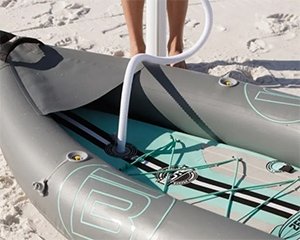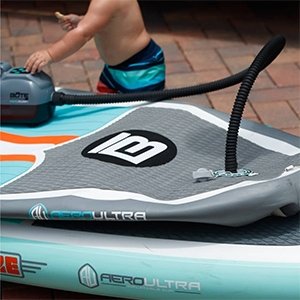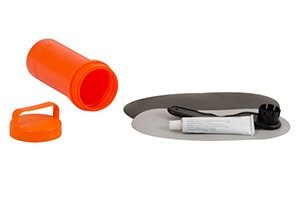The best inflatable kayaks use highly durable materials and multiple air chambers to keep your boat afloat. Also, evolving inflation technology has only improved the safety of inflatable kayaks. So in answer to the question ‘are inflatable kayaks safe?’ – the answer is yes, absolutely!
In some cases, like with white water rafting, an inflatable kayak might even be the safest option. Let’s take a closer look at inflatable kayaks and their features to learn a little more about this.
Key Takeaways
- Inflatable kayaks are safe and durable, and can even be better than hard shell kayaks in some situations.
- They have multiple air chambers, which prevent them from sinking if one chamber is punctured.
- Inflatable kayaks can be repaired easily with a patch kit and can be temporarily fixed on the water if needed.
- These boats require proper inflation, maintenance, and usage to ensure their safety and performance.
What Makes Inflatable Kayaks Safe?
As stated, well built inflatable kayaks are incredibly safe. A high quality, well-crafted inflatable kayak can outrank the safety of even a traditional hard shell kayak.
This is all down to the construction and materials of inflatable kayaks, which has a direct impact on how they perform on the water. Let’s take a closer look at how, and why:
Related: Sit-in vs sit-on kayaks.
Built for Durability
The safety of some of the best inflatable kayaks is largely due to their durable construction. Beyond the PVC or Hypalon inflatable material, the best inflatables have multiple layers that contribute to their durable construction.
In many instances, when you hit rough waters, rocks, or other obstructions in the water, your inflatable watercraft will typically bounce off.
It’s not just the material that’s working on your side, it’s also how they are built. While inflatable kayaks are built to mimic the construction of a hard shell, inflatables are generally wider.
The wide construction of an inflatable kayak gives your boat more stability.
You are less likely to tip over the way you would in a regular hardshell kayak. Not only that, but if you do tip over, you’ll have a much easier time getting back on to your inflatable. The wide inflatable tubes along the side chambers give you the stability that a hard shell can’t offer.
Also read: How to get in and out of a kayak.
If your boat has an I-beam flooring or drop stitch flooring, the construction will also make it easier to hop back on.
You may also like: Do inflatable kayaks need to be registered?
Multi Chamber Construction

One of the greatest benefits of an inflatable kayak is the multiple chamber construction.
Unlike a hard shell kayak, an inflatable kayak won’t sink quickly if it gets punctured. In fact, you’ll have a really difficult time sinking your inflatable kayak, even if the puncture is on the base.
Inflatable kayaks that have multiple chambers typically have three separate parts that are inflated individually. They include the base and the two side chambers. If one chamber suffers a puncture, you will almost always be able to make it back to shore safely as the other two chambers will keep you afloat.
Unlike an inflatable kayak, if you suffer a puncture while on the water, your boat can flood with water and capsize. However, it’s worth noting that puncturing a hard shell kayak while out on the water is typically unheard of. Unless of course, you are kayaking over sharp rocks and you crash into them.
Another great benefit of inflatable kayaks is that if you do happen to puncture them, you’ll typically be able to repair them.
The same can’t always be said for hard shell kayaks. Some hard shell kayaks are made out of fiberglass or composite material which can have a hard time bonding to other materials. This can make it super difficult to repair them if you suffer a puncture.
Related: Are inflatable kayaks any good?
Safety Precautions for Inflatable Kayaks
The surefire way to ensure your safety while on the water is by following basic safety rules. These safety measures should be applied no matter whether you’re using an inflatable kayak, boat, or hard shell watercraft.
Also read: How to get in your inflatable kayak.
Wear Safety Gear

No matter your expertise level, you should always wear the proper safety gear when you’re kayaking. Always wear a life jacket and make sure that your life jacket is properly secured.
If you have younger children on the boat, they should not only wear a life jacket because it can save their life, but because it’s also the law.
Every state has its own rules and regulations regarding personal floatation devices. However, almost every state will fine you anywhere from $40 to $250 for not wearing a life jacket while kayaking.
If you are going whitewater rafting, a life jacket can save your life. Whitewater rapids are extremely dangerous if you fall into them, and not having the proper gear can cost you your life.
In addition to wearing the right safety gear, it’s helpful to bring along a safety kit too. In your safety kit, you’ll want to include a repair kit in case you need to repair a leak while on the water. If you are someone who does extreme kayaking like white water rafting or sea kayaking, it can be helpful to have a marine emergency radio as well.
Related: How to paddle a kayak.
Don’t Go Over Capacity
No matter how great your inflatable kayak is, if you don’t use it according to the weight capacity you’re compromising your safety. Every inflatable kayak comes with a recommended weight capacity.
For a one person kayak, the weight capacity is typically 250 – 300 lb. For tandem kayaks or two seaters, the seating capacity will typically be around 650 lb.
The weight capacity is designated to accommodate the kayaker and any additional gear they may bring along. Never go over capacity with your kayak or else you risk it’s integrity while out on the water.
Related: How to stay dry on a sit-on-top kayak.
Steer Clear of Obstructions
When you’re out kayaking, be sure to stay in the open water. Don’t go near the edges where you can run into shrubbery, branches, broken tree limbs, or a sharp rock.
Even in shallow water, if your kayak gets caught up and obstructs, you might get stuck. Trying to free yourself from the obstruction can easily lead to a puncture.
Your best bet it’s staying safe and protecting your inflatable is by steering clear of these obstructions at all costs.
Use Your Kayak as Intended
Knowing the type of kayak you have and its intended use will keep you safe on the water. For example, if you are using a flat bottom fishing kayak to tackle white rapids, you can easily cause yourself to capsize.
Even worse, you may even end up puncturing your boat. The same goes for recreational, touring, and tandem kayaks.
Also read: How to clean and dry your inflatable kayak.
Don’t Fear the Rapids
No matter the type of kayak you are on, you will experience rapids and slight waves. If you’re out on the open ocean, or a large lake, these waves might be more intense. No matter your kayak or the wave type, it’s best to hit waves head-on. If you hit a wave at an angle, you increase your chances of flipping over.
Don’t be afraid of the waves. But know that you’ll feel them bounce off you as you pass over them. If you have a kayak that has a narrow v-shaped bottom or rubberized keel, you’ll have a better chance cutting through the waves. This will help minimize the amount of bounce you’ll feel.
Related: How much wind is too much for kayaking?
Inflate Your Kayak Properly
It’s important to inflate your kayak to its intended PSI. Low inflation won’t allow your kayak to support the intended weight. You’ll also find that an under inflated kayak is less stable due to the lack of air.
Also read: How to inflate a kayak?
When you’re inflating your kayak, it’s important to start with the floor chamber first. This is the base of your kayak which all the other chambers will inflate around.
When you are inflating the base, it can be helpful to inflate it to 60% before you move on to the side chambers. Inflating the base partially will allow the side chambers to sit properly once you begin inflating them.
When you move on to the side chambers, inflate those to 60% too. This will give your kayak a chance to settle. Partial inflation will also allow you to double check all the chambers as well as the kayak as a whole to make sure all components are sitting as they should.
Once the kayak looks good, then you can go back and inflate the entire kayak at 100%. Start with the base and then move on to the side chambers.

Electric, Hand, or Foot Pump?
You have a couple of options when it comes to inflating your kayak. All inflatable kayaks should come with a pump, and a majority of the time the pump will be a hand or foot powered pump.
Hand pumps are powered by pushing down on them. They are effective, but can take some time. Hand pumps are inflated by a foot pedal and can also be cumbersome because they are manual too.
You don’t have to use the pump that comes with your kayak. To speed up the process you can swap out the included pump for an electric kayak pump instead. If you are going to use an electric pump, pay close attention as you inflate to make sure that you don’t over-inflate your kayak.

As you inflate, make sure you are using the proper valve attachment on your pump. After you inflate your kayak, make sure that you properly secure the valve so that no air leaks out while you are out on the water.
Putting your ear up against the valve and pushing against the kayak is one way to check if there is an air leak. If you hear a hiss or feel air leaking out of the valve, this is an indication that you have not properly secured the valve.
Avoid Over Inflation
Knowing how much air to put in your kayak is important for having a safe inflatable to take out on the water. Every kayak will come with an instruction manual that tells you exactly how much air to put in.
Some kayaks will come with a transparent inflation ruler. This ruler is meant to be placed over an inflation template that is painted onto the side chamber of the boat. As you inflate, you’ll want the painted ruler on the side chamber to line up with your transparent inflation ruler. When these two match, this is an indication that you’ve inflated to the correct PSI.
Other boats will indicate a PSI, and you’ll need to inflate until you reach that measure on your pump’s PSI gauge.
Most inflatable kayaks require a PSI ranging from 1.5 to 2.5 PSI. However, with some inflatable kayaks that are made out of a high-quality drop stitch construction, the inflation can be anywhere from 10 to even 15 PSI.
Always check with your owner’s manual first before you begin inflation. Overinflating your kayak will compromise the integrity of your kayak. This may cause your kayak to warp as too much pressure is put on the seams.
In extreme cases, your kayak may even burst.
Also read: What size kayak do I need?
Will an Inflatable Kayak Sink After a Puncture?
Perhaps one of the best features of an inflatable kayak is that if you suffer a puncture on the water, you won’t immediately sink. In fact most times, you won’t sink fast enough, giving you plenty of time to get back to shore.
The best types of inflatable kayaks will feature at least three air chambers. If one air chamber happens to sustain a puncture, the other two chambers should keep you afloat. If you sustain a puncture while you are out on the water, it’s incredibly important to get back to shore.
In cases where you are far from land or are kayaking out in the ocean or a large lake, you may need to call for help or repair the leak yourself while you’re still out on the water. (more on that in a moment).
Related: What is the difference between inflatable kayak and rigid kayak?
Fixing a Puncture on Your Inflatable Kayak

So youtube hit some jagged rocks or other sharp objects and you think your boat might have a leak. Another one of the best benefits of inflatable kayaks is the fact that you can repair them. Repairing your inflatable boat properly can extend its lifespan significantly. In nearly every case, the process is simple and straightforward. Here’s what you’ll need to do:
- Start by locating the leak. You can inflate the kayak and test the area to make sure you’ve located the leak and that you only have one. If you’re having trouble finding the leak, examine the seams. Punctures can sometimes occur here and be very well hidden from view.
- Deflate your boat.
- Clean the impacted area using a warm soapy solution and allow it to dry completely.
- Next, you’ll need to apply a repair patch. Your inflatable kayak should come with a small patch kit. If not, you’ll need to use some sort of neoprene fabric.
- Apply the glue over your kayak then place the patch over the puncture.
- Use a flat material or repair patch tool to flatten the patch. Your goal is to remove any air bubbles.
- Allow the patch to dry for at least 12 hours before you inflate your boat again.
Pro tip: If your boat ever sustains a puncture, you can contact the manufacturer. They may be able to provide you with additional assistance with repairs.
Fixing a Puncture While Out on the Water
Sometimes accidents happen. Perhaps you drop a knife on your boat while you’re out fishing, or your dog accidentally punctures a chamber with their claw. Even the most high quality inflatable technology can sustain punctures while on the water.
Related: Can dogs go in an inflatable kayak?
If you ever find yourself in a situation where you’re out on the water with a puncture, and you’re too far from land, then you may need to repair the puncture at that moment. While this is extremely rare, it’s important to know what to do in case you’re ever faced with this situation.
In an event like this, preparation is key. It’s best to always pack along a safety kit that includes a small bottle of soapy solution, acetone, duct tape, and a hand pump. Here’s what you’ll need to do:
- The first step is to stay calm. Remaining calm will keep you level headed so that you can work efficiently.
- Start by locating the leak . If the leak is easily accessible, then you can move forward with a temporary repair. Spray solution on the boat where you think the leak is and look for the soap to bubble. If you see bubbles, that’s where the leak is. Double check by putting your finger over the area to feel for the escaped air.
- Clean the area off as best you can with acetone, then dry it off.
- Next, tear off a piece of duct tape and place it over the leak.
- Whether or not air escapes after you have closed the leak, you’ll want to take out your hand pump and start pumping air back into the chamber.
- If you have someone else on board with you, have them pump air while you paddle back to shore. It’s important that you do not overinflate the boat either. Doing so can exacerbate the leak.
You will have to rely on your hand pump if you cannot find the leak or if the leak is under the boat or somewhere you can’t reach. To get back to shore safely, you’ll want to use the hand pump to continue putting air back into the chamber while kayaking back to shore.
Safety Benefits of Inflatable Kayaks
For novice kayakers, putting your trust in an inflatable kayak can be overwhelming. But there are so many reasons to consider an inflatable kayak. Here are some of the great Safety benefits you can look forward to.
a. Inflatable Kayaks Are Lightweight
The lightweight construction of an inflatable kayak allows it to be easier to navigate on the water. Their lightweight construction also allows them to be incredibly buoyant too.
Also read: How much does a kayak weigh?
b. Inflatable Kayaks Offer Great Stability
New kayakers will also enjoy how stable inflatable kayaking feels. The wide base does not rock back and forth the way hard shell kayaks do. An inflatable fishing kayak with a rigid floor can often beat out the stability that is offered by a hardshell kayak.
c. Inflatable Kayaks Are Slow
Inflatable kayaks are much slower than hardshell kayaks. Inflatable tandem kayaks are even more so.
A safety benefit of this is that you’ll have plenty of time to avoid an obstruction if one is in your path. You’ll have a greater reaction time which can help you avoid a puncture. This can be especially helpful if you are doing some whitewater kayaking.
Related: Kayak vs inflatable boat.
Conclusion
Inflatable kayak safety is one of the top concerns many kayakers have when it comes to inflatable kayaks.
The good news is that modern inflatable kayaks take safety very seriously. Some of the best brands have constructed their inflatable kayaks so that their safety outranks even the best hardshelled kayaks on the market.
I hope our safety guide has helped clear up some misconceptions you may have had. Let us know in the comments section what some of your favorite inflatable kayak safety features are.

